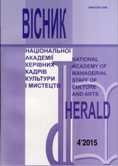КОМУНІКАЦІЙНІ ПРОЦЕСИ ЯК ОСНОВА ІСНУВАННЯ КУЛЬТУРИ
Communication processes as a basis for the existence of culture
Author(s): Vladyslav Viktorovich KornienkoSubject(s): Ethics / Practical Philosophy, Communication studies, Cultural Anthropology / Ethnology, Culture and social structure , Sociology of Culture
Published by: Національна академія керівних кадрів культури і мистецтв
Keywords: culture; theory of culture; communication; communication system; communication culture paradigm;
Summary/Abstract: In the article the author makes scientific theorizing of culture communication factor. Representing a variety of cultural and cultural-philosophical paradigm of cultural contents and cultural process, the author actualizes the communication factor of its existence. The focus of theorists and historians of culture, culturologist, artists and practitioners of culture on the aforesaid problems, enhancing of the relevance of the aforementioned issues, a variety of scientific and practical generalizations of these problems require a systematic study and justification of culture as a communication system.So, the communication paradigm of culture appears as a subject of modern scientific discourse. In turn, cultural reflection provides consideration to culture communication paradigm in the context of studying its diversity and integrity.This statement can be argued as follows. Firstly, the theory of culture studies a whole system of culture, which is constituted largely through stable communication links, maintaining the integrity of the culture in time and space. Secondly, modern cultural theory contains the most urgent task the study of the pathways and impacts of culture and its separate elements on society, life and development of social groups, on human consciousness. The impact of culture on the field "society" is carried out as information and communication process associated with a targeted communication, perception, understanding and assimilation. Thirdly, the theory of culture owes its occurrence, the intensification of processes of intercultural exchange, increase and deepen the contacts between different cultures. Fourth, the cultural aspect of the phenomenon of communication is clearly manifested in the study of the processes of artistic culture, where the significant role is played by communication between creator and consumer of art belonging to different cultural communities. Finally, the theory of culture is based on the integration of modern human knowledge, and mutual interpenetration of the various sciences. Moreover, the nature of communication greatly influences the formation of the subject of cultural studies, defining its objectives and problems.In the context of M. Kagan’s activity approach we have identified the following system-forming sections of culture as communication.First. Any conscious activity is carried out in two dimensions: material and ideal (spiritual). On the one hand, human’s acts are aimed to specific objective results, on the other they create models that reflect or replace reality and mimic its separate niche in the audio, graphical, spatial, mathematical, verbal and other forms. These two measurements form a coherent structure of communication as the basis of culture.Second. Any conscious activity includes two components: reproductive, reproducing, based on the repetition of already known samples, and specific to humans, that is productive, creative, which provides the appearance of new, unknown, original solutions. Consequently, there is a spectral variety of traditions interaction forms and innovations.To justify the communication paradigm of culture subject field, the author refers to one of the functions, which reveals the essential content of a material component of culture, namely: information, symbolic, or semiotic. It should be noted that items of culture along with an instrumental purpose have clearly expressed information – that is, perform the function of transmitting messages using the language of objective form. Anything can have a meaningful magic links and any shape can be informed.As a result of consideration of the substantive communication form in the historical context and cultural analysis, we have identified its main theoretical paradigm: the content and structural-functional dimensions, and a number of its substantial forms.In the space-time continuum (structural shear) subject forms of communication appear as a spectrum of generalized four objects: the subject of the environment, three-dimensional things, materialized processes – four ontological layers.In the functional space substantive work placed between the practically-useful poles of object creation and artistic development of reality. The moving combination of polar principles creates a range of fundamentally different types of subject creativity culture – its "climate" zones.The author emphasizes that culture has been creating by human. Regardless of epoch, there are search and way of mastering spiritual meanings in culture. Culture combines rational and sensible that ultimately forms the source of its existence. Cultural identity imagination combined with individual experience. In a process of culture creation the past is embodied in the present.The human community (mainly at an advanced stage of vital activity) is a huge information-synergetic anthropo-sociology system. Human is a creator of their culture and at the same time its product. Semiotic culture makes multilingual conversation with the help of languages: the language of religion and myth, science and art, ideas and meanings, emotions and feelings, pattern recognition and making of solutions, collective behaviour and common life creation.
Journal: Вісник Національної академії керівних кадрів культури і мистецтв
- Issue Year: 2015
- Issue No: 4
- Page Range: 53-59
- Page Count: 7
- Language: Ukrainian

